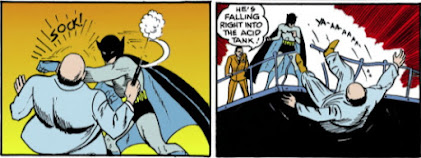Detective Comics, No. 27 (May, 1939)
"Bruce Wayne is a nice young chap—but he certainly must live a boring life." -Commissioner Gordon
The first Bat-Man story has a built-in twist that's often forgotten: Bruce Wayne's double identity as Bat-Man isn't revealed until the final panel. Of course, the Bruce Wayne-Commissioner Gordon dynamic is highly reminiscent of the relationship between Lamont Cranston and Commissioner Weston in The Shadow radio series, which had been on the air for two years when Batman debuted, so it's a rather predictable twist. Within the story itself, it's a nice touch, and gives another layer of mystery to the plot.
Speaking of plot, it's typical 1930s pulp fair. Stryker, our villain, is trying to take over the Apex Chemical Corporation by murdering its owners. The exact nature of Stryker's scheme is a little unclear (something about signing contracts with each of the owners and then killing them and stealing back the contracts), but the specific's aren't important. Honestly, I'm not even sure his plan makes any sense. The Bat-Man, naturally, uncovers the scheme and punches Stryker into a pool of acid in his first-ever kill.
The Bat-Man of this issue doesn't have a clear motivation in fighting crime, and neither he nor his alter-ego Bruce Wayne are developed beyond the most basic level. Given that the story is a mere 6 pages, that's to be expected. The tropes Kane is playing with—mysterious vigilante, rich playboy—were already familiar to readers in this genre. What really sets the Bat-Man apart is his striking design and enigmatic nature. The twist at the end—while predictable—is a brilliant tease: nothing about how Bruce Wayne came to be Bat-Man is explained.
It's easy to see why readers wanted more of this "adventurous figure fighting for righteousness."


Comments
Post a Comment